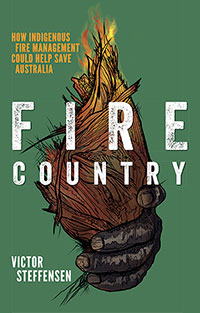-
Member Login
- Home
- About
- Institute Groups
- Membership
- Events
- News & Publications
- Institute Programs
- Resources
- Jobs Board
- Contact Us
- Site Info
NAIDOC Week Book Review | 'Fire Country' by Victor Steffensen
Review by Alan Chenoweth FEIANZ CEnvP
“… of all the explanations of Aboriginal knowledge systems as science, this is the one I would turn to..” (Prof Marcia Langton AM)
 In April 2020, I watched ABC TV’s “Australian Story” which aired a program titled “Fighting Fire with Fire”, featuring Victor Steffensen, an Aboriginal fire practitioner who became the face of the Indigenous cultural burning movement in the wake of the disastrous 2019-20 Australian bushfire season. He is also a storyteller, writer, musician and filmmaker, with a passion for Indigenous culture. With impeccable timing, his book “Fire Country: How Indigenous Fire Management Could Help Save Australia” was also published in 2020, after the mega-fires which devastated over 16 million hectares, destroyed 2500 homes, and directly caused 29 deaths as well as half a billion animals; and Australians grappled with the realisation that we have not been managing our landscape in ways appropriate for our climate. The message of “Fire Country” is simple – we must learn from, adopt and adapt cultural burning practices more widely if we to live harmoniously with the Australian landscape.
In April 2020, I watched ABC TV’s “Australian Story” which aired a program titled “Fighting Fire with Fire”, featuring Victor Steffensen, an Aboriginal fire practitioner who became the face of the Indigenous cultural burning movement in the wake of the disastrous 2019-20 Australian bushfire season. He is also a storyteller, writer, musician and filmmaker, with a passion for Indigenous culture. With impeccable timing, his book “Fire Country: How Indigenous Fire Management Could Help Save Australia” was also published in 2020, after the mega-fires which devastated over 16 million hectares, destroyed 2500 homes, and directly caused 29 deaths as well as half a billion animals; and Australians grappled with the realisation that we have not been managing our landscape in ways appropriate for our climate. The message of “Fire Country” is simple – we must learn from, adopt and adapt cultural burning practices more widely if we to live harmoniously with the Australian landscape.
Victor grew up in Kuranda, North Queensland, knowing little of his Indigenous culture and history (his mother is a Tagalaka woman from the Gulf Country); but was mentored in land management by two knowledgeable Cape York elders – the story of this relationship is a thread throughout the book, including Victor’s work with Dr Peta-Marie Standley and the two elders (who were each awarded Honorary Doctorates from James Cook University for their contributions to her PhD).
‘Fire Country’ is a highly personal account of how the author has learned, trialled and taught Indigenous fire management, sprinkled with anecdotes in a direct but elegantly sparse writing style, in which his personality comes across – sometimes expressing his profound love of country and respect for elders, sometimes with disappointment at mismanagement of the environment, at times defensive, and occasionally with anger and frustration with bureaucracy.
For me, coming from a background in vegetation ecology, the ‘light bulb’ moments are associated with Steffensen’s descriptions of traditional lore and ‘reading the country’ – native trees are the key to understanding what types and frequency of fire are needed, but the understory (especially grasses and soil) holds the key to fire timing. The experience and skills required to feel the moisture levels with your fingers, and know what that means for burning each type of country, and how the breeding and movement cycles of animals and plants will react, are part of a traditional evidence-base that complements more modern science. Cultural burning can also control weeds and restore ‘sick’ land to health, although it may take many years.
Although fire management is only part of the complex knowledge base and lore associated with traditional Indigenous practices, it is symbolic and readily comprehended by most audiences, and can be a basis for understanding how other aspects of traditional knowledge relate to science and environmental management.
There is also another level to the interpretation of cultural burning, that of facilitating a dispossessed people to reconnect with country. Fire is way to start the process of reconnection, it has a spiritual dimension and tells a story. Those who learn to read the landscape for cultural burning, will also learn much about how to manage the land and water, the biodiversity, food sources and useful plants. This is arguably equally important for disconnected peoples – the settler society for the Northern Hemisphere who still have at best a shallow connection to the Australian landscape and its variable climate. Steffensen argues that cultural burning offers solutions for modern Australians faced with the threat of catastrophic bushfires – there is right way to burn, a right way to look after country.
This is a deceptively simple but important book with the potential to be a game-changer at the present time, when demand for recognising and learning from Indigenous environmental management is growing exponentially. As the author himself states: “The fire is just the beginning of understanding the important journey ahead for us all”.
|
Steffensen, Victor (2020) “Fire Country: How Indigenous Fire Management Could Help Save Australia” (Hardie Grant). NOTE: Book sales benefit the Firesticks Alliance Indigenous Corporation |
We acknowledge and value the rights and interests of Indigenous Peoples in the protection and management of environmental values through their involvement in decisions and processes, and the application of traditional Indigenous knowledge.

